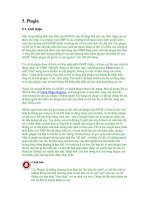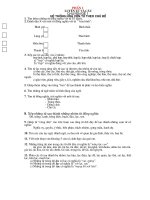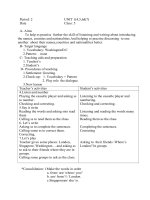- Trang chủ >>
- Mầm non - Tiểu học >>
- Lớp 5
5 1 uncovering amerias past
Bạn đang xem bản rút gọn của tài liệu. Xem và tải ngay bản đầy đủ của tài liệu tại đây (3.18 MB, 10 trang )
Fascinating Facts
• California has the highest present-day American
Indian population of any of the fifty states.
• Some American Indian mothers carried infants in
a cradleboard, a lace-up bag made of animal skin
on a wooden frame.
• Corn, beans, and squash were important foods to
the American Indians. The Iroquois called them
the “three sisters.”
by Stephanie Sigue
Genre
Nonfiction
Comprehension Skill
Summarize
Text Features
• Sidebars
• Captions
Scott Foresman Social Studies
ISBN 0-328-14886-5
ì<(sk$m)=bei gi< +^-Ä-U-Ä-U
Archaeologists search all over the United States for clues about
American Indian history. They do this to better understand how
American Indians lived long ago. In this book you will learn how
this search tells us where and how people lived long ago.
Vocabulary
Uncovering
America’s Past
Write to It!
Think about the different American Indian groups you
have read about. Which group would you like to learn
more about? What would you like to know? Choose a
group, and explain why in two or more paragraphs.
Write your paragraphs on a separate sheet of paper.
archaeologist
longhouse
lodge
tepee
pueblo
mesa
artifact
totem pole
Photographs
by Stephanie Sigue
Every effort has been made to secure permission and provide appropriate credit for photographic material. The publisher deeply
regrets any omission and pledges to correct errors called to its attention in subsequent editions.
Unless otherwise acknowledged, all photographs are the property of Scott Foresman, a division of Pearson Education.
Photo locators denoted as follows: Top (T), Center (C), Bottom (B), Left (L), Right (R) Background (Bkgd)
ISBN: 0-328-14886-5
Copyright © Pearson Education, Inc.
All Rights Reserved. Printed in the United States of America. This publication is protected
by Copyright, and permission should be obtained from the publisher prior to any prohibited
reproduction, storage in a retrieval system, or transmission in any form by any means,
electronic, mechanical, photocopying, recording, or likewise. For information regarding
permission(s), write to: Permissions Department, Scott Foresman, 1900 East Lake Avenue,
Glenview, Illinois 60025.
1 2 3 4 5 6 7 8 9 10 V0G1 14 13 12 11 10 09 08 07 06 05
Opener: ©Gary Braasch/Corbis
2 ©Warren Morgan/Corbis
3 ©Stock Montage Inc.
Editorial Offices: Glenview, Illinois • Parsippany, New Jersey • New York, New York
4 ©The Image Works, Inc.
5 ©Marilyn “Angel” Wynn/Nativestock
Sales Offices: Needham, Massachusetts • Duluth, Georgia • Glenview, Illinois
6 ©North Wind Picture Archives
Coppell, Texas • Sacramento, California • Mesa, Arizona
9 ©Bettmann/Corbis
10 ©Joseph Sohm; ChromoSohm Inc./Corbis
12 ©Hemera Technologies/Alamy
13 ©Ernest Manewal/SuperStock
14 ©Gary Braasch/Corbis
15 ©Lowe Art Museum/SuperStock
When an archaeologist begins to study a group of
people, he or she hopes to answer certain questions.
When and where did these people live? What can we
learn about how they lived? What kinds of things did they
leave behind?
Scientists know that people lived in North America for
many centuries before Europeans came. These American
Indians, or Native Americans, lived in each region of the
country, from the Atlantic coast to the Pacific coast and
from the Great Lakes to the Gulf of Mexico. Each region’s
natural resources were important to how they lived. What
we know about how American Indians lived long ago
comes from the work of archaeologists as well as the
knowledge passed on to American Indians today.
Archaeologists work at a dig in Wenatchee, Washington.
2
This model shows an Iroquois longhouse.
American Indians of the
Eastern Woodlands
One of the major groups of the Eastern Woodlands
were the Iroquois. The name Iroquois is used to describe
the members of several American Indian groups. These
groups include the Mohawk, the Seneca, the Onondaga,
and the Oneida. Each was a group living in the forested
regions of the Eastern Woodlands.
The Iroquois were farmers who usually built their
villages on high ground. This way they could more easily
protect themselves against attacks.
Within each village the Iroquois built longhouses. A
longhouse had living spaces as well as places for storing
things. Each was about 20 feet wide and from 75 to 120
feet long. The frame was made of wooden poles and
covered with tree bark.
As many as twelve families could live in a single
longhouse. Each family had its own living space with
raised platforms for sleeping and storage. Walls
separated them from other families. There were cooking
fires at the center of the longhouse.
3
In what is the present-day Southeastern United
States, American Indians lived in towns and villages
that had three common features. One feature was a
round meetinghouse with a domed room where the
town leaders met. Another feature was a central town
square, or stomp ground, for special ceremonies. The
third feature was a large court where games were
played. Family homes were usually built around the
village border.
The Seminole chickee was built on a platform to avoid flooding.
This picture shows a Creek log house and its inhabitants.
The Creek, the Chickasaw, the Choctaw, and the
Cherokee all lived in the Southeast. These groups built
plain rectangular dwellings. Their houses were made of
wood with roofs made of reed-like plants or straw.
Originally part of the Creek, the Seminole lived in
Florida, where it was hot, humid, and swampy. Some
Seminole lived in small houses with open sides called
chickees. They were built on platforms to avoid flooding
during heavy rains. People hung cotton fabric from the
beams to keep out bugs and rain.
4
5
This is how a Mandan village looked in the 1800s.
American Indians of the
Great Plains
The Mandan and the Hidatsa lived in villages along the
upper Missouri River in North Dakota. They built earth
lodges. Some lodges were built near the river and others
were built near the forests. These lodges were used when
trees were used to make fires.
Each lodge had a dome shape. They were between
forty and sixty feet wide and about fifteen feet high.
Lodges had a roof made of wooden beams covered with
willows, grass, and sod. There was a central fireplace
inside where many social activities took place. Animal
hides were used to separate the sleeping quarters from
the rest of the house. A family kept all of its belongings
inside the home, including dogs and horses. Horses were
kept inside so they would not be stolen.
The Great Plains of the western and central United
States were home to many groups of American Indians.
Some were sedentary, meaning that they stayed in one
place and left only to go on buffalo hunts. For most of
the year they were farmers. These groups included the
Pawnee, the Omaha, and the Osage. They all lived in
earth lodges.
These lodges were square with a floor built below ground
level. The walls and roof were made from wooden poles,
which were covered with woven grass and mud. Beginning
at the base, the builders applied a coat of mud. The mud
kept the house warm in the winter and cool in the summer.
An opening, or smoke hole, was left in the roof’s center.
In the 1500s Spanish explorers brought horses with
them to North America. Their arrival changed the ways of
life of American Indians of the Great Plains. Horses made
hunting easier and allowed American Indian groups to
travel farther and faster. Over time, many of these groups
became nomads who moved from place to place.
6
7
Changing Ways of Life
Most American Indian groups of the Great Plains
were not sedentary. They were nomadic people who
were always traveling. They hunted buffalo and followed
the herds that moved across the region. The Sioux, the
Cheyenne, the Comanche, the Blackfoot, and the Crow
were some of the many nomadic groups who lived in the
Great Plains.
The nomadic groups of the Great Plains created
a home called the tepee that could be taken down
easily, carried away, and rebuilt. It had a cone-shaped
frame made from long, tall wooden poles that were tied
together at the top and covered with buffalo hides. The
hides, from buffalo that had shed their winter coats,
were replaced once a year.
The first tepees were small. Trained dogs could help
carry the poles and hides when a group moved. After the
groups of the Great Plains began to use horses, however,
their tepees became larger. With horses they could move
their belongings more easily.
Wickiups
Other nomadic groups built disposable homes.
When they moved, they left these homes behind. The
Paiute, the Shoshone, and the Ute groups lived on the
Great Plateau between the Sierra Nevada and Rocky
Mountains. They built wickiups, homes with a cone
shape. They were made with a lightweight frame covered
by grass.
Tepees were covered with buffalo hides. Once a year
each tepee was covered with a new, fresh hide.
Moving Tepees
Tepees started off small, and trained dogs would
carry the poles and hides when the group moved. After
Spanish explorers brought horses to North America,
the tepees became larger. With horses, American Indian
groups of the Great Plains could move their tepees and
belongings more easily.
8
9
American Indians of the
Desert Southwest
Mesa Verde’s largest cliff dwelling is called the Cliff Palace,
which has 217 rooms and 23 kivas. A kiva is a circular
underground room used for religious ceremonies.
American Indians of the Desert Southwest built a
variety of homes. The Mogollon (moh-GOH-yohn) and the
Hohokam (huh-HO-kum) built pit houses that were partly
under the ground. Each house was a rectangle with
wooden poles that leaned inward to support a roof. This
created walls that sloped. People covered the roof and
walls with branches and grass and then with a layer of
adobe, or mud.
American Indian cliff dwellings and pueblos are two
of the most amazing finds made by archaeologists
in the Desert Southwest. Cliff dwellings were found in
an area called Mesa Verde (MAY-seh VEHR-dee). This is
located in the “Four Corners” region of the United States
where the present-day borders of Utah, Colorado, New
Mexico, and Arizona meet. An ancient group known as the
Anasazi built these dramatic buildings, located below a
mesa and set among steep cliffs. Some cliff dwellings are
small and housed only a few families. Others are large
apartment-like buildings where hundreds of people lived.
After the Anasazi left the Four Corners region, new
communities formed farther south. The people who
moved there built pueblos. A pueblo contains rooms that
are stacked one on top of another. Each higher story is
set back from the one below. People used ladders to
move from one dwelling to another.
Large pueblos are called great houses. Some have
hundreds of rooms. Some of the largest and most
famous examples are in Chaco Canyon in New Mexico.
10
11
Art and Artifacts
Archaeologists are interested in more than just
dwellings. They also look for artifacts, such as tools,
weapons, clothing, pottery, and baskets—anything that
can help them learn more about a culture.
Tools and weapons can tell scientists how people
hunted for food. From the size and weight of a weapon,
experts can tell how hunters used it.
An eagle appears on the beadwork of a Tlingit (TLING-git)
ceremonial robe in Alaska.
American Indians were—and are—expert weavers,
potters, basket makers, and carvers. Scientists can
date some of the American Indian artifacts found by
archaeologists to prehistoric times.
Before Europeans arrived in the Northeast, American
Indian women of the Eastern Woodlands made clothing
from animal skins and decorated the clothing with
porcupine quills. They often dyed the quills before
sewing them onto a garment. When Europeans moved
west they brought new materials with them, including
glass beads. American Indian women began to use fancy
beadwork to decorate their clothing.
People have found American Indian
arrowheads all over the United States.
12
13
The American Indians of the Pacific Northwest carved
wooden totem poles to tell the story of a family tree.
For example, a family might claim a relationship with a
particular animal. That animal would be carved on the
family’s totem pole. Some totem poles are more than
forty feet high.
This Navajo blanket
was made in the
late 1800s.
This is an example of a totem pole found
in the Pacific Northwest.
In the Desert Southwest, some of the most famous
Navajo weavings are chiefs’ blankets. These works
of art use patterns, such as stripes, zigzags, and
diamond shapes.
Today many of the special objects made by American
Indians are collected by people and museums around
the world. The National Museum of the American Indian
in Washington, D.C., contains more than 800,000 works.
The pieces are from North and South America, and they
cover a period of ten thousand years.
These artifacts, along with the histories passed on to
American Indians today, contribute to our understanding
of how American Indians of long ago lived.
15
Glossary
Archaeologists
search
all overwho
thestudies
United States
for clues
archaeologist
a scientist
the artifacts
of about
American
Indian
They
doand
thisdraws
to better
understand how
people
whohistory.
lived long
ago
conclusions
American
fromIndians
them lived long ago. In this book you will learn how
this search tells us where and how people lived long ago.
artifact an object made by people in the past
lodge a large, round hut built by American Indian
groups of the GreatVocabulary
Plains
archaeologist
longhouse a building used
for shelter by the Iroquois
Write to It!
Think about the different American Indian groups you
have read about. Which group would you like to learn
more about? What would you like to know? Choose a
group, and explain why in two or more paragraphs.
Write your paragraphs on a separate sheet of paper.
longhouse
mesa a high, flat landform
that rises steeply from
the land around it
lodge
pueblo an American Indiantepee
village of the Desert
Southwest region of thepueblo
United States, typically
made up of stone or adobe dwellings
mesa
tepee a dwelling built by American Indians of the
artifact
Great Plains
totem
pole with animals or
totem pole a wooden post
carved
other images; often made by American Indians
of the Pacific Northwest to honor ancestors or
special events
Photographs
Every effort has been made to secure permission and provide appropriate credit for photographic material. The publisher deeply
regrets any omission and pledges to correct errors called to its attention in subsequent editions.
Unless otherwise acknowledged, all photographs are the property of Scott Foresman, a division of Pearson Education.
Photo locators denoted as follows: Top (T), Center (C), Bottom (B), Left (L), Right (R) Background (Bkgd)
ISBN: 0-328-14886-5
Copyright © Pearson Education, Inc.
All Rights Reserved. Printed in the United States of America. This publication is protected
by Copyright, and permission should be obtained from the publisher prior to any prohibited
reproduction, storage in a retrieval system, or transmission in any form by any means,
electronic, mechanical, photocopying, recording, or likewise. For information regarding
permission(s), write to: Permissions Department, Scott Foresman, 1900 East Lake Avenue,
Glenview, Illinois 60025.
1 2 3 4 5 6 7 8 9 10 V0G1 14 13 12 11 10 09 08 07 06 05
16
Opener: ©Gary Braasch/Corbis
2 ©Warren Morgan/Corbis
3 ©Stock Montage Inc.
4 ©The Image Works, Inc.
5 ©Marilyn “Angel” Wynn/Nativestock
6 ©North Wind Picture Archives
9 ©Bettmann/Corbis
10 ©Joseph Sohm; ChromoSohm Inc./Corbis
12 ©Hemera Technologies/Alamy
13 ©Ernest Manewal/SuperStock
14 ©Gary Braasch/Corbis
15 ©Lowe Art Museum/SuperStock









